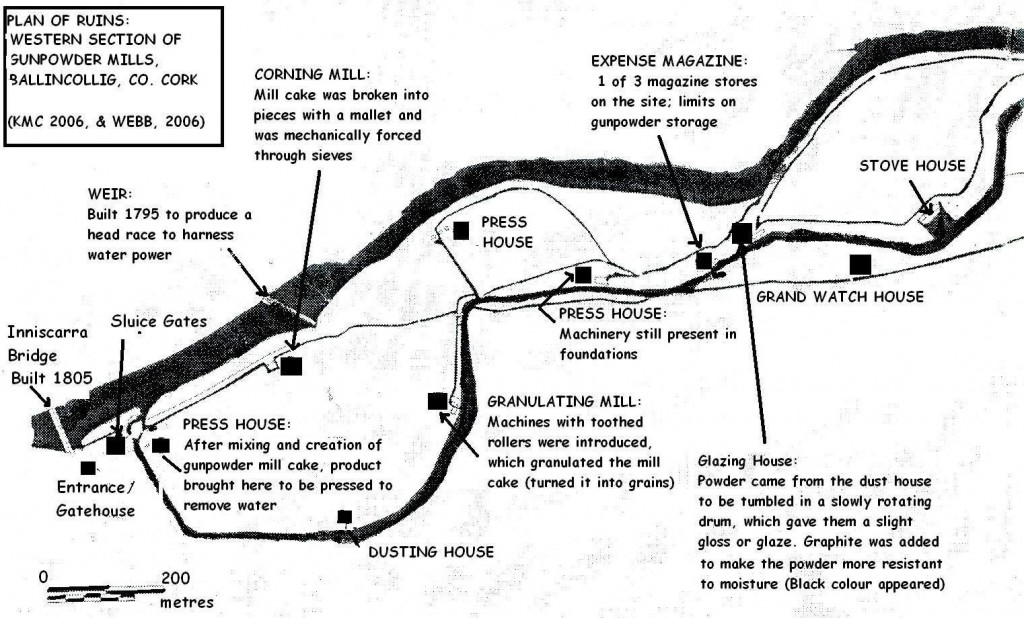Kieran’s Our City, Our Town Article, Cork Independent
– 18 February 2010
In the Footsteps of St. Finbarre (Part 201)
The Industrious Landscape
A newspaper article in the Cork Constitution in 1856 gives a very important insight into the stages of gunpowder production at Ballincollig Gunpowder Mills. Once refined etc, the three ingredients of gunpowder – sulphur, saltpetre and charcoal were then removed to the mixing house. The journalist in 1856 could not ascertain the precise proportions or parts of the final mix. He noted that the process was religiously kept and never divulged to strangers. However, the usual proportions given by chemists were 75 of saltpetre, 15 of charcoal and 10 parts of sulphur.
The mixed ingredients were then sent to the composition mills, which consisted (similar to the sulphur, saltpetre and charcoal grinding mill) of two stones vertically placed and running on a bed stone. On this stone the composition was spread and wetted. The composition mills were small buildings. Only a small quantity of composition was worked there at a time, as explosions could sometimes happen from the runners and bed stone coming is contact and from other causes.
The composition taken from the mills was sent in the form of mill-cake to another department of the manufactory, where it was subjected to a violent pressure from a powerful screw-press. The next part of the operation was the breaking up of the press-cake into fragments. This was effected by a large mallet, by which the workmen broke up the gunpowder into small pieces to render its suitable for the action of the corning mill. The gunpowder thus reduced into fragments was transferred to the corning house to be corned or grained. The corning mill consisted of a number of circular sieves, in each of which were two flat circular pieces of lignum vitae or trade wood of a tough dense nature. The sieves were made of parchment skins, having round holes punched through them. Several of these sieves were fixed in a frame. That machinery moved so that the lignum runner in each sieve struck against the powder with a quick velocity breaking the lumps of powder and forcing them through the sieves, forming grains of several sizes.
The next operation was called glazing. It consisted in putting a small degree of gloss on the powder, rendering it less liable to be affected by moisture. For this purpose, the powder was placed in a reel. The reel was kept slowly revolving for some time by which the grains of gunpowder were brought into contact with each other, producing a slight gloss. The next process was stoving or drying. The stoving house comprised of a securely closed chamber, heated by steam passing through large steam-tight tubes. The powder was spread on cases placed on shelves, rising tier above tier round the room. The heat was regulated by a thermometer placed at the door.
The gunpowder was either stored in bags (for home use), or in casks of various sizes, containing from 5 to 100 pounds. The manufacture of the casks constituted an important feature of the operations carried on in connection with the powder mills. It gave employment to about fifty coopers, besides a large number of subsidiary trades. The cutting and shaping of the staves and heads of the casks were performed by machinery. The saw mills comprised a number of vertical, straight and circular saws, worked by the new motive principle entitled the turbine. The machines were noted as long been used on the European continent and farther afield in Syria but only in the years leading up to the Constitution report began to used in Ireland.
The turbine, which was employed in 1856, was constructed by Mr. Perrott. It was of 16 horse-power and was water powered producing 100 revolutions of the shaft per minute. The rounding off the head of casks was completed by a circular saw of peculiar construction by which a skilful workman could complete as many as 250 to 300 heads in an hour.
The number of people employed in the several operations of the Ballincollig Gunpowder Mills was about 500. When apprentices to coopers and tradesmen were wanted they were selected from the sons of the men employed on the works, as a reward for good conduct and long services. One great advantage attending the manufacture was that it furnished employment for both sexes and for every age. Indeed a man with the assistance of one or more members of his family could make upwards of three guineas per week. As a result, the men employed on the mills, the majority of whom with their families resided on the estate were deemed by the visiting journalist as amongst the most comfortable of the manufacturing population.
In addition each family connected to the mills resided in a little cottage with a small piece of ground attached rent free. The visiting journalist in 1856 described the neat and orderly appearance of the little dwellings with clean white washed walls and “trimly” kept gardens. He felt they created the feel of a traditional English village rather than the typical habitations of Irish families. However, he further highlighted that the neatness and cleanliness of the cottages was secured through the periodical inspection by an officer who was employed to check dwellings. Indeed, the walls of the buildings were whitewashed every month.
To be continued…
Caption:
527a. Sketch map of mill ruins, western section of Ballincollig Regional Park (source: Kieran McCarthy & work of Jenny Webb, Ballincollig)
